Introduction
Asians are seen to have a great love for side dishes as they add more flavours to the main meal making it more enjoyable. Kimchi has become a global dish due to its gut-friendly benefits. It is a spicy fermented vegetable found as an accomplishment in almost every traditional South Korean meal 1. The word kimchi traces its origin to Chimchae, a Chinese word that translates into pickled vegetables with salt 2. It is made by fermenting vegetables, such as napa cabbage1 and radish. Chinese cabbage makes the most common type of kimchi; however, it can also be prepared with various other vegetables. This side dish perhaps provides the most incredible insights into Korean cuisine and how it evolved into a sophisticated culinary style over time. Hundreds of different vegetables can be used as the main ingredients in kimchi.
Kimchi has gained recognition over the last decade mainly due to its sour flavour. It was initially sustenance food for the Korean people, who depended on their agricultural production to get through the harsh winters. Using the fermenting method, vegetables offered the best ability to preserve for a more extended period. The Koreans gradually perfected the art of salt fermentation. Today, about 200 different types of kimchi exist in Korea 3. The most common Kimchi (Napa cabbage Kimchi) is served in every Korean meal. A medium to large cabbage is used in its preparation. It is then fermented with various tantalizing seasonings, most importantly salt. Generally, a Korean cheonilyeom (coarse sea salt), with a rough texture that is minimally processed, is used in brining and developing the flavours of the vegetables. This salt is natural, without bitterness. After this, kimchi is placed into an earthenware pot, which undergoes a quick and active fermentation process. Kimchi is easily fermented within 3–4 days at room temperature.
Beyond being incredibly delicious, Korean kimchi is widely recognized as a beneficial probiotic food. It is rich in lactobacilli, which kills germs and harmful bacteria while delivering various health benefits4. Because of its physiologic nutrients, phytochemicals, and probiotics like lactic acid bacteria, kimchi is considered a healthy diet 5, offering benefits such as antioxidants, antimutagenic, anticarcinogenic, and antihypertensive properties. Pathogenic bacteria and contaminations are eradicated during the preparation and fermentation, making it a hygienically safe food 6–10. According to Kim et al. (2018) 7, the lactic acid bacteria found in kimchi demonstrated protective effects against several diseases, such as stress, asthma, cancer, hypertension, and inflammation. Kimchi boosts sensory qualities and tastes and allows the intake of highly beneficial bioactive compounds 11.
Meanwhile, the amount of scientific data generated in recent years, paired with new communication channels, prompted the research community to propose the bibliometrics analysis, thus, spawning a new discipline. Bibliometric analysis is focused on identifying a corpus of literature within a specific subject area. Researchers use it to provide quantitative analysis and systematically categorize written publications 12. Though it began with a bibliographical overview of the most cited publications, it has since expanded to include geographical 13,14 or institutional aspects and performance indicators such as growth 15, subject domains 15–21, or types of literature and authorships 22–24. The evaluations also cover various material types, including journal articles, books, theses, patents, and reports. Though it has been widely used in medicine, social science, computer science, environmental science, etc., there are limited bibliometrics studies in culinary and related disciplines 25–29, prompting this study to fill this gap.
Thus, this study’s main objectives are to review publication trends since 1979 and to recognize the nature of the collaboration among various research constitutes of Kimchi literature. This study also sought to analyze the evolution of Kimchi literature based on co-citation analysis, examine the status of Kimchi literature based on author keywords, and identify the clusters. Another aim of this study is to discover the major themes of Kimchi literature. Therefore, this uses bibliometric data for year, country, institutions, authors, subject category, and keywords. The current study also provides bibliometric data for citation analysis and keyword co-occurrence analysis.
Research Methodology
Search and eligibility criteria
The research database included in this research is Scopus. Scopus is a comprehensive database enriched with a highly maintained abstract and citation database connecting to scholarly literature from a wide range of fields. Scopus coverage includes nearly 22794 active titles across 11,678 publishers. The subject coverage includes life, social, physical, and health sciences. It includes book series, journals, and trade journals also. Additionally, articles published in the Scopus database are peer-reviewed. Therefore, we used Scopus as a data source for searching articles on kimchi.
We used the keyword “Kimchi” in the article title to retrieve data for analysis. Articles were retrieved from the Scopus database. The search strategy for the inclusion of articles was TITLE (Kimchi) AND (LIMIT-TO (DOCTYPE, “ar”) OR LIMIT-TO (DOCTYPE, “re”) ). This means that the keyword “Kimchi” was searched in the title, and only research articles and review articles containing this keyword were included in the bibliometric analysis.
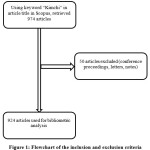 |
Figure 1: Flowchart of the inclusion and exclusion criteria |
Data Analysis
To observe the evolution of the literature on kimchi, we adopted the bibliometric analysis method for the 924 selected articles. Bibliographical techniques were performed, such as co-authorship, citation and co-occurrence analyses. Data analysis was done using a Visualization Of Science (VOS) viewer, a freely available software. This software can generate, visualize, and discover various research themes based on network data and analyze bibliometric networks 30. VOS viewer software is superior to other visualization tools because it can handle large data sets and create graphics that clearly illustrate the hotspots and research areas 31. Though VOS viewer is a potent tool, it has certain drawbacks. For example, the inability of VOS viewer to provide other types of visualizations beyond network graphs. In particular, thematic analysis plots the topics along two-dimensional (Density vs Centrality). This is quite helpful in identifying emerging clusters and the significance level of each cluster. As a result, we have also used Biblioshiny, an app providing a web interface for bibliometrics, to identify the different themes of kimchi’s research.
Findings
Trends in Kimchi literature by years, countries, institutions and authors
Out of the 924 articles, the majority (288) were published in open access (31%). 120 (13%) articles had golden access, whereas 15 had hybrid access. One hundred and one articles (11%) had green access. However, 225 (24%) articles had subscription-based access. Also, 909 (98%) of the articles were original research papers, while the remaining were (2%) review papers. Many articles were published in English (743, 81%), followed by Korean (20%). Others were in Japanese, Chinese and Slovenian languages.
The trend in the publication of Kimchi’s research since 1979 is shown in Figure 1. These results suggest steady growth of publications since 2016. The initial data shows that 160 journals have contributed 924 articles between 1979-2022. Interestingly, there are already ten articles published in the year 2022. Of 924, 616 articles (66.66%) were published in the last ten years (2012-2021). The search revealed that the earliest article on kimchi was by 32 on the Inoculation of Kimchi. Inoculation protects someone from disease by administering an infectious substance, germs, or vaccination to their body. Though the first article was published in 1979, no articles were published for the next decade, i.e., between 1980-89. Later, gradually there was upwards growth in the publications. Studies between 1990 and 1999 were published on the subject of microbiology, immunology, biochemistry, genetics, biology, and agricultural sciences. Fifty-two articles were published during this period. Between 2000-2009, 189 articles were published. Of 189, 31 articles were published in the nursing domain.
Further, analysis reveals many articles published during the last decade (531). New disciplines of studies that emerged during this period were medicine (55 articles), social sciences (19 articles), business, management and accounting (4 articles) and health professionals (6 articles). Four articles published were multidisciplinary. One hundred and ninety-one articles were published between 2020 and 2021, suggesting kimchi is still the subject of interest for researchers from different disciplines.
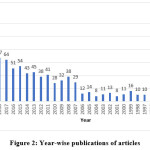 |
Figure 2: Year-wise publications of articles |
The geographical locations of the institutions that have contributed to the literature on kimchi are depicted in Figure 3. It is found that South Korea contributes nearly 94% (868 articles) of the total contribution, followed by the United States, China, and Japan. This suggests that the geographical distribution of these institutes is majorly located in South Korea and the United States.
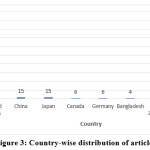 |
Figure 3: Country-wise distribution of articles |
The institution-wise analysis (Figure 4) of the published articles based on the authors’ affiliations suggests that most articles have been published by South Korean Institutes, followed by the United States. While the World Institute of Kimchi published 151 articles, Pusan National University contributed 69 articles. The other three institutes with more than 50 articles were Korea Food Research Institute, Konkuk University, and Kyung Hee University. Together, these five institutes reported for 43 % of the overall publications. The institutions with at least ten articles published are presented in Figure 4.
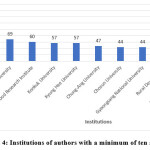 |
Figure 4: Institutions of authors with a minimum of ten articles |
Figure 5 depicts authors with 19 or more articles, accounting for 26% of the total contribution (238 of 924 articles). The authors with a minimum of 20 articles are Park, K.Y. (36), Chang, H.C. (30), Lee, M.A. (26), Song, Y.O. (26), Choi, H.J. (21), Chang, J.Y. (20), Lee, J.H. (20), and Lee, N.K. (20).
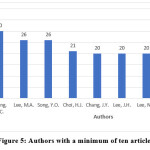 |
Figure 5: Authors with a minimum of ten articles. |
Co-authorship network of authors and countries
One of the critical components of multidisciplinary research is collaboration in research. Research collaboration is how researchers collaborate to generate innovative scientific understanding. A collaborative analysis is crucial to comprehend academic communication and knowledge diffusion better. Therefore, we conducted a co-authorship analysis using VOS viewer to evaluate and assess scientific collaboration patterns, notwithstanding the disagreement over its meaning and interpretation. Identification of authors and their connections uncovers the social structure of the networks 33. This work focuses on analyses of structural properties in the co-authorship network using centrality measures. Therefore, we conducted two types of co-authorship analysis: collaboration between authors and countries. The collaboration between institutes was not conducted because there was no consistency in their names. Co-authorship analysis of authors having a minimum of twenty articles with at least one citation was carried out. Of the 1962 items (or 924 articles), 19 authors met this threshold (Figure 6).
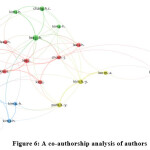 |
Figure 6: A co-authorship analysis of authors. |
The elements included in this map are the authors and the co-authorship links. Each link has a strength that indicates articles co-authored by these authors. This analysis resulted in five clusters. The first cluster (red) had seven authors Choi H.J., Kim H. J., Kim J., Kim S., Lee J., Lee J.H. and Lee S.H. The second cluster (green) had four authors: Chang H.C., Kim J.H., Kim J.H. and Lee J.H. The third (blue) and fourth clusters (yellow) had three authors each (Kim S.H., Kim S.H. and Lee S. and Kim H.Y., Lee M. A. and Park K. Y. The fifth cluster (purple)had only two authors: Lee N.K. and Paik H.D. Further, Lee H. J. has the highest total strength (26), followed by Park H.W (23) and Choi H. J. (22). Whereas Lee, J. and Lee, M.A. had equal strength of 19.
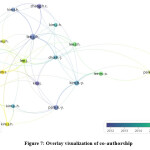 |
Figure 7: Overlay visualization of co-authorship. |
The overlay visualizations (Figure 7) show the collaboration over time. While the purple node represents the traditional authors, and the yellow nodes depict the latest authors. Based on the yellow node, it can be inferred that Kim S.H and Lee S. Kim S. are three authors who have contributed to the Kimchi literature through their collaborative work since 2017.
The co-authorship analysis of countries with a minimum of five articles by an author with at least one citation resulted in six documents (Figure 8). The analysis resulted in a cluster of six countries based on the total strength link: South Korea, the United States, China, Germany, Japan, and Canada. This reveals that the authors from the United States had a maximum collaboration with South Korean authors, followed by China, Germany, Japan, and Canada. The overlay visualizations suggest that considerable collaborative research has been undergoing in China since 2018. However, other countries have yet to make their contribution and collaboration.
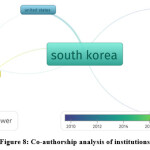 |
Figure 8: Co-authorship analysis of institutions. |
Most cited documents, authors, and journals
Figure 9 provides the list of top ten journals that have published at least twenty articles between the period 1979 to 2022. According to this, the most number of articles were in “The Journal of Korean Society of Food Science and Nutrition”(79), followed by “Food Science And Biotechnology”(70), and “Journal Of Microbiology And Biotechnology” (62).
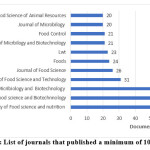 |
Figure 9: List of journals that published a minimum of 10 articles |
Further, we conducted a citation analysis(CA). CA uses citations in scholarly publications to build relationships with others’ works or scholars. It is one of the most popular bibliometrics techniques. In this analysis, research productivity is measured by the times it is cited in other studies. Generally, CA is carried out to a) measure the impact of the work; b) learn more about the subject; c) investigate the contribution of a particular author within and beyond his/her discipline; and e) for promotion and tenure purposes. Therefore, considering all these, we have conducted CA for documents, authors, and sources. The CA for documents with a minimum of 140 citations resulted in 10 documents. The authors and titles of the top-cited documents are presented in Table 1.
Table 1: Documents with a minimum of 140 citations.
| No. | label | Title of the document | Link Weight | Citations |
| 1 | Jung (2011) | Metagenomic analysis of kimchi, a Traditional Korean fermented food | 5 | 344 |
| 2 | Cheigh (1994) | Biochemical, Microbiological, and Nutritional Aspects of Kimchi (Korean Fermented Vegetable Products) | 6 | 300 |
| 3 | Kim (2005) | Bacterial community structure in kimchi, a Korean fermented vegetable food, as revealed by 16S rRNA gene analysis | 6 | 207 |
| 4 | Cho (2007) | Production of γ-aminobutyric acid (GABA) by Lactobacillus buchneri isolated from kimchi and its neuroprotective effect on neuronal cells | 1 | 197 |
| 5 | Park (2014) | Health benefits of Kimchi (Korean fermented vegetables) as a probiotic food | 6 | 194 |
| 6 | Lee (2005) | Analysis of kimchi microflora using denaturing gradient gel electrophoresis | 7 | 182 |
| 7 | Jung (2012) | Effects of Leuconostoc mesenteroides starter cultures on microbial communities and metabolites during kimchi fermentation | 9 | 168 |
| 8 | Cho (2006) | Microbial population dynamics of kimchi, a fermented cabbage product | 5 | 163 |
| 9 | Park (2012) | Bacterial community analysis during fermentation of ten representative kinds of kimchi with barcoded pyrosequencing | 1 | 160 |
| 10 | Lee (2011) | Functional properties of Lactobacillus strains isolated from Kimchi | 2 | 142 |
Further, CA was also carried out concerning authors. Authors with a minimum of 20 articles and one citation were included in the analysis (Table 2). This resulted in 19 authors.
Table 2: Citation analysis of authors.
| No. | Author | Total link strength | Documents | Citations |
| 1 | Lee S.H. | 281 | 28 | 1345 |
| 2 | Chang H.C. | 185 | 32 | 1041 |
| 3 | Park K.Y. | 271 | 33 | 903 |
| 4 | Paik H.D. | 185 | 31 | 667 |
| 5 | Kim J. | 167 | 24 | 666 |
| 6 | Lee J.H. | 267 | 45 | 600 |
| 7 | Choi H.J. | 147 | 23 | 554 |
| 8 | Lee N.-K. | 162 | 21 | 500 |
| 9 | Kim H.Y. | 182 | 32 | 489 |
| 10 | Lee J. | 145 | 29 | 470 |
Finally, CA was also conducted for the sources of the articles. For this, the sources with a minimum of 20 articles on kimchi with at least one citation were considered. This accounted for ten sources (Table 3).
Table 3: Citation analysis of journals.
| No. | Source Title | Total link strength | Document | Citations |
| 1 | Journal of the Korean society of food science and nutrition | 146 | 79 | 460 |
| 2 | Food science and biotechnology | 271 | 70 | 802 |
| 3 | Journal of microbiology and biotechnology | 223 | 62 | 1185 |
| 4 | Korean journal of food science and technology | 69 | 31 | 138 |
| 5 | Journal of food science | 147 | 26 | 582 |
| 6 | Foods | 125 | 24 | 70 |
| 7 | Lwt | 125 | 23 | 351 |
| 8 | Korean Journal of microbiology and biotechnology | 118 | 22 | 211 |
| 9 | Food Control | 107 | 21 | 405 |
| 10 | Journal of microbiology | 77 | 20 | 345 |
Significant clusters of Kimchi research themes
Further, we created the co-occurrence map of author keywords (minimum threshold of 10 keywords) using the VOS viewer software (Figure 10). The keyword that appeared most frequently was “Kimchi”. The location of the word “Kimchi” at the map’s centre points to this keyword’s centrality. The other two frequently used keywords were “lactic acid bacteria” and “fermentation”.
The co-occurrence of keywords also resulted in six clusters with 31 items: Kimchi making process, Kimchi fermentation process, microbial properties of kimchi, microbes, lactic acid bacterium and virulence factor of kimchi.
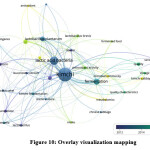 |
Figure 10: Overlay visualization mapping. |
Major themes of study on kimchi
Further, based on the 2080 author keywords, nine themes were identified. The topic location on the thematic map determined its development degree and relevance.
The two most important topics were #1 Properties of Kimchi, and #2 Quality and sensory evaluation of kimchi. The basic topics were # 1 Kimchi fermentation and #2 microbes involved in Kimchi fermentation. The two niche topics were #1 apoptosis and #2 Gram-positive bacterium. The emerging topics in the Kimchi literature were #1 Health benefits of Kimchi, #2 Quality of Kimchi and #3 Bacteria involved in the Kimchi fermentation (Figure 11).
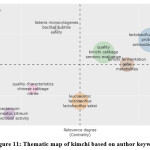 |
Figure 11: Thematic map of kimchi based on author keywords. |
Discussion
This study provides an overview of the kimchi literature from 1979 to 2022, for which data were collected from the Scopus database. Several bibliometric analyses were conducted using 924 documents. First, we examined the general trends in the publication of research articles. This analysis included dominant countries, year-wise growth of published research articles, institutes, and authors involved in the research on kimchi. Additionally, this study identifies the most relevant journals and the most studied topics in the domain of kimchi literature. All the 924 articles were further analyzed using various bibliometric methods. For example, co-authorship, co-occurrence, and citation analyses to identify the major trends in this area of research.
Concerning research question 1, i.e., general characteristics of published articles, we found that, since 2007, there has been a considerable increase in the number of articles published. Second, South Korea emerged as the dominant country, contributing nearly 94% (868 articles) of the total. Third, with 151 articles, the World Institute of Kimchi published the most articles on kimchi, followed by Pusan National University. Finally, forty-four authors published more than ten articles. Based on this, we can conclude that most of the literature is from South Korea, although there are some contributions from other countries, such as Germany, the USA, China, and Canada.
The second research question of this study was to investigate the co-authorship pattern across authors and countries to understand scientific collaboration patterns. This analysis yielded a three-cluster solution. The first two clusters had four authors, and the third cluster had only two authors. Further, Lee H. J. has the highest total strength (26), followed by Park H.W (23) and Choi H. J. (22). The overlay visualization of co-authorship suggests that although significant research studies started emerging in 2007, a collaboration between the authors started in 2013. The co-authorship analysis revealed that authors from the United States had a strong collaboration link with South Korea. The overlay visualization revealed that the authors from Germany initially collaborated with South Korean authors in 2010. Later, in 2012 authors from the United States emerged in the collaborative work, followed by Canada in 2014. However, lately, China has emerged as a collaborating country with South Korea. Surprisingly, other countries have yet to contribute and collaborate in the Kimchi literature.
The third research question was to find the most cited documents, authors, and journals. As per CA, the most cited document with 168 citations and a link weight of nine was “Effects of Leuconostoc mesenteroides starter cultures on microbial communities and metabolites during kimchi fermentation” published in the journal “International Journal of Food Microbiology” by Jung J.Y. in the year 2012. Interestingly, the second top-cited study was also by Jung J.Y., titled “Metatranscriptomic analysis of lactic acid bacterial gene expression during kimchi fermentation” in the same journal in 2013. The third most cited document was “Kimchi and other widely consumed traditional fermented foods of Korea: A review” by Patra J.K. This was published in the Journal “Frontiers in Microbiology” in 2016.
Regarding the CA of authors, it was found that Lee, S. H. was the most cited author with 1345 citations across 28 documents having total link strength of 281. The second most cited was Park K. Y., with 903 citations across 33 documents and a total link strength score of 271.
The CA of sources revealed that the articles from the Journal “Food science and biotechnology” had 802 citations across 70 documents. This was followed by the “Journal of microbiology and biotechnology” having 1185 citations across 62 documents with total link strength of 62. The third and fourth sources were “International Journal of Food Microbiology” and “Journal of Food Science”, with 215 and 147 total link strength scores, respectively.
The fourth research question was identifying kimchi’s major cluster of research streams. For this purpose, we performed a co-occurrence analysis using author keywords. The assessment resulted in six clusters: Kimchi making process, Kimchi fermentation process, microbial properties of kimchi, microbes, lactic acid bacterium and virulence factor of kimchi. The first cluster (Kimchi making process) had 12 keywords related to the process involved in kimchi makings, such as fermentation, Kimchi cabbage, microbial community, quality, sensory evaluation, and storage. The second cluster had six keywords related to Kimchi fermentation, such as bacterial species associated with the fermentation of kimchi and starter culture. Starter culture is a blend of living microorganisms purposefully applied to facilitate Kimchi fermentation. The third cluster had five keywords related to the microbial properties of kimchi, for example, antioxidant activity, lactobacillus brevis, lactobacillus plantarum, probiotics, and probiotics. The fourth cluster had four keywords related to microbes involved in kimchi, such as bacteriocin, Kimchi, Lactobacillus and leuconostoc. The fifth cluster had two keywords related to a lactic acid bacterium, such as lactobacillus brevis, presented in kimchi. Lactobacillus brevis is used by a vast range of fermented goods worldwide. Similarly, the sixth cluster also had two keywords, bacteriocin and listeria monocytogenes, related to the Virulence factor.
Further, the overlay network visualization suggests that the studies on Kimchi fermentation started in 2012 and later focused on the microbial properties of kimchi from the year 2014 up to 2016. Since 2018 studies have been focusing on the metabolomics of kimchi. Metabolomics is the “systematic study of the distinct chemical fingerprints that specific biological functions leave behind.”
The fifth research question was to identify major study themes using the authors’ keywords to identify the themes in the Kimchi literature. We found nine themes: Properties of Kimchi, Quality and sensory evaluation of Kimchi, Kimchi fermentation, microbes involved in Kimchi fermentation, apoptosis, Gram-positive bacterium, Health benefits of Kimchi, Quality of Kimchi and Bacteria involved in the Kimchi fermentation.
The motor theme, i.e., properties of kimchi, had sub-topics such as lactobacillus plantarum, probiotics, and antioxidant activity. Studies on this theme focused on the probiotics extracted from kimchi cultures and their anti-inflammatory and antioxidant properties. The second theme in this quadrant was kimchi’s quality and sensory evaluation. The topics included in this theme were quality, Kimchi cabbage and sensory evaluation. The primary theme in the Kimchi literature was Kimchi fermentation and the microbes involved in Kimchi fermentation. The kimchi fermentation theme included kimchi, lactic acid bacteria and fermentation. The microbes’ theme had keywords such as Gaba and metabolites. The two niche themes identified were apoptosis and Gram-positive bacterium. The theme of apoptosis, a programmed cell death, plays a vital role in cancer cell study had two sub-topics: oxidative stress and inflammation. This theme focuses on the studies on the nutritional benefits of kimchi.
Finally, three emerging themes were identified: health benefits, Quality of Kimchi, and bacteria involved in the Kimchi fermentation.
The first theme (Health benefits) had sub-themes such as leuconostoc, Lactobacillus and Lactobacillus sakei. Kimchi lactic acid bacteria (LAB) confer probiotic properties and immunomodulatory and anti-obesity benefits 34. In human clinical trials, kimchi is also found to impact the lipids in the serum, gut microbiota, iron level, obesity, and metabolic markers. It impacted the epidemiology of free radicals, cholesterol, hypertension, asthma, atopic dermatitis, rhinitis, and asthma. A study investigating kimchi’s health benefits revealed that it has antioxidative, antiaging, anticancer, and anti-obesity 35.
The second emerging theme in Kimchi literature is the quality of kimchi. A recent study36 on the fermentative and antioxidant properties of Godulbaegi Kimchi revealed that LGK is a sufficient food with significant antioxidative activity and an antibacterial effect. Similarly, other studies have also focused on the different aspects of the quality of kimchi. For example, the effects of high hydrostatic pressure treatment and micro-perforated film packaging on the quality of kimchi sauce 37, quality characteristics of commercial kimchi manufactured38, the effect of cooling rate on Kimchi quality39, and fermentation with leuconostoc mesenteroides ATCC 8293 as starter culture 40.
The third emerging topic was bacteria involved in Kimchi fermentation. LAB is a major bacteria impacting kimchi’s quality, safety, and organoleptic properties 41. Based on this, a recent study investigates the role of LAB strains from different raw materials41. The study’s findings revealed the ecological function of LAB starters in food fermentation and bacteriophages as modulators of bacterial populations related to kimchi’s fermentation capabilities. Studies have also investigated the combined effect of different salt concentrations and LAB fermentation 42, probiotic-type strains of LAB as a starter culture for Kimchi fermentation 43, a combination of two LABs (Leuconostoc mesenteroides and Lactobacillus sakei ) as starter culture 44. A recent review article provides evidence for the effects of Kimchi or Kimchi LAB on stress, cancer, hypertension, and immunity. The finding also suggests that studies focus on the quality of the kimchi, such as improving shelf-life and storage under fluctuating temperatures.
Though numerous articles were published in the health, nutrition, and food science domain, our study did not find any significant literature on other essential aspects of the research area, such as the economic impact of kimchi on citizens’ overall well-being. According to a recent report by Globenewswire, the global Kimchi market is expected to grow by $ 975.93 mn during 2022-2026. Therefore, future studies should focus on trends, growth drivers, and vendors’ challenges. The Kimchi market is also positively impacted by increased consumption since kimchi contains vitamin A, which can aid in fighting cancer-causing free radicals. Expanding product development, packaging advancements, and developments also give companies in the kimchi market additional lucrative chances 45. This could be another research area that future studies can focus on.
One of the methods used to segment the Kimchi market is type, application and product. The identified segments are kimchi made up of cabbage, radish water, curbed radish, green onion, and cucumber. The Kimchi market is further divided into application segments: household and commercial segments. Conventional and organic are the two segments based on product types 45. Therefore, marketing researchers should focus on segmenting the consumer market based on other factors such as health benefits, quality of kimchi, and lifestyle-related factors. This will help Kimchi marketers formulate appropriate marketing strategies to position kimchi.
Future studies should also focus on consumer behaviours such as cultural, social, personal, and psychological factors. Additionally, there are no studies on consumers’ attitudes and behavioural intentions regarding Kimchi consumption. Further, it is found that kimchi’s health benefits, quality, and food properties can be optimized by manipulating the types and amounts of ingredients and appropriate probiotic starter culture 35. The global kimchi market is anticipated to develop as consumers worldwide turn to novel and sensory products rather than traditional staple foods. Therefore, future research should focus on new food development of Kimchi varieties.
Though our study has many findings and implications, it also has a few limitations. First, the articles for this study were recovered from Scopus. The articles from other databases were omitted. Second, only peer-reviewed and review articles were considered for analysis within the Scopus database. The other forms of publications, such as book chapters, conference papers, editor notes, and letters, were excluded. Third, an integrated review and analysis of such literature would help us to understand the subject matter more comprehensively. This would help in creating a holistic view of Kimchi literature. Fourth, future studies can focus on topic modelling techniques such as Structural Topic Modeling.
Conclusion
This study adopts bibliometric analysis to explore the knowledge base of Kimchi literature. The analysis resulted in 924 articles from the Scopus database between 1979 and 2022. Not surprisingly, South Korea emerged as a predominant country contributing to Kimchi literature. Though kimchi originated in South Korea, many authors from the United States of America have also published many articles. Also, results reveal that only a handful of countries have studied kimchi and related aspects such as fermentation method, bacteria involved, health and nutritional benefits etc. This study’s significant contribution is identifying emerging themes in Kimchi literature. Our findings identify three major emerging themes: health benefits, quality, and use of different types of combinations of bacteria as a starter culture. The finding of this study is helpful for future researchers in identifying the research gap, evaluating the impact of research, monitoring the research trends, and identifying the research themes of Kimchi. This study also helps them advance their understanding of the Kimchi knowledge base.
Acknowledgement
We would like to express our heartfelt gratitude to Dr Rajesh Pai, Department of Humanities and Management, MIT, Manipal Academy of Higher Education, for providing his valuable input on bibliometric analysis studies
Conflict of Interest
There is no conflict of interest.
Funding Sources
There is no funding sources
References
- Hongu N, Kim A.S., Suzuki A, Wilson H, Tsui K.C., Park S. Korean kimchi: promoting healthy meals through cultural tradition. J Ethn Foods. 2017;4(3):172-180.
CrossRef - Park K.Y., Kil J.H., Jung K.O., Kong C.S., Lee J.M. Functional properties of kimchi (Korean fermented vegetables). In: Acta Horticulturae. Vol 706. International Society for Horticultural Science; 2006:167-172.
CrossRef - Jang D.J., Chung K.R., Yang H.J., Kim K.S., Kwon D.Y. Discussion on the origin of kimchi, representative of Korean unique fermented vegetables. J Ethn Foods. 2015;2(3):126-136.
CrossRef - Chang H.C. Healthy and safe Korean traditional fermented foods: kimchi and chongkukjang. J Ethn Foods. 2018;5(3):161-166.
CrossRef - Sapalina F, Retnaningrum E. Molecular characterization of lactic acid bacteria producing edible biofilm isolated from kimchi. Biodiversitas. 2020;21(3):962-968.
CrossRef - Suh M, Moon H, Han H, Ham S. Invisible and Intangible, but Undeniable: Role of Ambient Conditions in Building Hotel Guests’ Loyalty. J Hosp Mark Manag. 2015;24(7).
CrossRef - Kim H.J., Noh J.S., Song Y.O. Beneficial effects of kimchi, a Korean fermented vegetable food, on pathophysiological factors related to atherosclerosis. J Med Food. 2018;21(2):127-135.
CrossRef - Kim B, Mun E.G., Kim D, et al. A survey of research papers on the health benefits of kimchi and kimchi lactic acid bacteria. J Nutr Heal. 2018;51(1):1-13.
CrossRef - Le B., Anh P.T.N., Yang S.H. Enhancement of the Anti-Inflammatory Effect of Mustard Kimchi on RAW 264.7 Macrophages by the Lactobacillus plantarum Fermentation-Mediated Generation of Phenolic Compound Derivatives. Foods. 2020;9(2).
CrossRef - Thilakarathna W.P. Yu C.H.J., Rupasinghe H.P.V. Variations in nutritional and microbial composition of napa cabbage kimchi during refrigerated storage. J Food Process Preserv. 2021;45(12).
CrossRef - Jung S.J., Kim M.J., Chae S.W. Quality and functional characteristics of kimchi made with organically cultivated young Chinese cabbage (olgari-baechu). J Ethn Foods. 2016;3(2):150-158.
CrossRef - Şahin A, Yılmaz G. Local food research: a bibliometric review using Citespace II (1970–2020). Libr Hi Tech. 2022;40(3):848-870.
CrosRef - Lin W.Y.C. Research status and characteristics of library and information science in Taiwan: A bibliometric analysis. Scientometrics. 2012;92(1):7-21.
CrossRef - Zhuang Y, Liu X, Nguyen T, He Q, Hong S. Global remote sensing research trends during 1991-2010: A bibliometric analysis. Scientometrics. 2013;96(1):203-219.
CrossRef - Huffman M.D., Baldridge A, Bloomfield G.S, et al. Global cardiovascular research output, citations, and collaborations: A time-trend, bibliometric analysis (1999-2008). PLoS One. 2013;8(12).
CrossRef - Goyal K, Kumar S. Financial literacy: A systematic review and bibliometric analysis. Int J Consum Stud. 2021;45(1):80-105.
CrossRef - Mao G, Hu H, Liu X, Crittenden J, Huang N. A bibliometric analysis of industrial wastewater treatments from 1998 to 2019. Environ Pollut. 2021;275.
CrossRef - Forliano C, De Bernardi P, Yahiaoui D. Entrepreneurial universities: A bibliometric analysis within the business and management domains. Technol Forecast Soc Change. 2021;165.
CrossRef - Khanra S, Dhir A, Kaur P, Mäntymäki M. Bibliometric analysis and literature review of ecotourism: Toward sustainable development. Tour Manag Perspect. 2021;37.
CrossRef - Sevukan R, Sharma J. Bibliometric Analysis of Research Output of Biotechnology Faculties in Some Indian Central Universities. DESIDOC J Libr Inf Technol. 2008;28(6):11-20.
CrossRef - Pai R.R., Alathur S. Bibliometric Analysis and Methodological Review of Mobile Health Services and Applications in India. Int J Med Inform. 2021;145.
CrossRef - Ghani M, Hurrell R, Verceles A.C., McCurdy M.T, Papali A. Geographic, subject, and authorship trends among LMIC-based scientific publications in high-impact global health and general medicine journals: a 30-month bibliometric analysis. J Epidemiol Glob Health. 2021;11(1):92-97.
CrossRef - Martinho V.J.P.D. Bibliometric analysis for working capital: Identifying gaps, co-authorships and insights from a literature survey. Int J Financ Stud. 2021;9(4).
CrossRef - Jacimovic J, Jakovljevic A, Nagendrababu V, Duncan H.F. Dummer PMH. A bibliometric analysis of the dental scientific literature on COVID-19. Clin Oral Investig. 2021;25(11):6171-6183.
CrossRef - Mostafa M.M. Three decades of halal food scholarly publications: A PubMed bibliometric network analysis . Int J Consum Stud. July 2022.
CrossRef - Bellia C, Bacarella S, Ingrassia M. Interactions between Street Food and Food Safety Topics in the Scientific Literature—A Bibliometric Analysis with Science Mapping. Foods. 2022;11(6).
CrossRef - Santana I, Matheus J.R.V, Serrano Pinheiro de Souza T, et al. Insights into Developing Persimmon-based Food Products: Bibliometric Analysis and the Innovative Formulation of Chutney and Ketchup. J Culin Sci Technol. 2022.
CrossRef - Lyu V.C, Lai I.K.W, Ting H, Zhang H. Destination food research: a bibliometric citation review (2000–2018). Br Food J. 2020;122(6):2045-2057.
CrossRef - Chan X.H, Sabaratnam V, Abdullah N, Phan C.W. A 53-year bibliometric and scientometric analysis of research in culinary and medicinal mushrooms. Int J Med Mushrooms. 2020;22(6):521-534.
CrossRef - Van Eck N.J, Waltman L. How to normalize cooccurrence data? An analysis of some well-known similarity measures. J Am Soc Inf Sci Technol. 2009;60(8):1635-1651.
CrossRef - Donthu N, Kumar S, Pattnaik D. Forty-five years of Journal of Business Research: A bibliometric analysis. J Bus Res. 2020;109:1-14.
CrosRef - RO S.L, Burn M.W., Sandine W.E. Vitamin b12 and ascorbic acid in kimchi inoculated with Propionibacterium freudenreichji ss. shermanii. J Food Sci. 1979;44(3):873-877.
CrossRef - E Fonseca B de P.F, Sampaio R.B., Fonseca M.V de A, Zicker F. Co-authorship network analysis in health research: Method and potential use. Heal Res Policy Syst. 2016;14(1):1-10.
CrossRef - Lim S.K., Choi H.J. Health Benefits of Lactic Acid Bacteria Isolated from Kimchi. ACS Symp Ser. 2019;1303:107-119.
CrossRef - Park K.Y., Kim H.Y., Jeong J.K. Kimchi and Its Health Benefits. Fermented Foods Heal Dis Prev. January 2017:477-502.
CrossRef - Lee J.H., Choi E.J, Chang J.Y, Chun H.H. Combined effects of high hydrostatic pressure treatment and micro-perforated film packaging on the quality of kimchi sauce stored under fluctuating temperature conditions. Food Eng Prog. 2021;24(4):243-250.
CrossRef - Yun Y.R., Ju Lee J, Jin Lee H, et al. Comparison of Quality Characteristics of Commercial Kimchi Manufactured in Korea, China, and the United States. mdpi.com. 2021.
CrossRef - Min S.G., Jeon J.Y., Han E.S. Effects of cooling rate on quality characteristics of spring kimchi cabbage (Brassica campestris L. ssp. Pekinensis) during cold storage. Food Eng Prog. 2021;25(2):102-109.
CrossRef - Li L, Yan Y, Ding W, Gong J, Xiao G. Improvement in the quality of kimchi by fermentation with leuconostoc mesenteroides ATCC 8293 as starter culture. Microbiol Biotechnol Lett. 2021;48(4):533-538.
CrossRef - Jung M.J, Kim J, Lee S.H. et al. Role of combinated lactic acid bacteria in bacterial, viral, and metabolite dynamics during fermentation of vegetable food, kimchi. Food Res Int. 2022;157.
CrossRef - Kim J.Y, Bae Y.M., Lee S.Y. Combined effect of various salt concentrations and lactic acid bacteria fermentation on the survival of Escherichia coli O157:H7 and Listeria monocytogenes in white kimchi at different temperatures. Food Sci Biotechnol. 2021;30(12):1593-1600.
CrossRef - Seo H, Bae J.H., Kim G, Kim S.A. Ryu B.H., Han N.S. Suitability analysis of 17 probiotic type strains of lactic acid bacteria as starter for kimchi fermentation. Foods. 2021;10(6).
CrossRef - Lee J.J, Choi Y.J, Lee M.J et al. Effects of combining two lactic acid bacteria as a starter culture on model kimchi fermentation. Food Res Int. 2020;136.
CrossRef - Data Bridge Market Research. Global Kimchi Market – Industry Trends and Forecast to 2029. Data Bridge Market Research. https://www.databridgemarketresearch.com/news/global-kimchi-market. Published 2022. Accessed July 7, 2022.

This work is licensed under a Creative Commons Attribution 4.0 International License.

